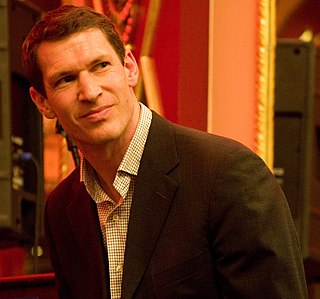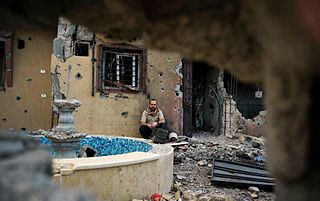
Photojournalism is journalism that uses images to tell a news story. It usually only refers to still images, but can also refer to video used in broadcast journalism. Photojournalism is distinguished from other close branches of photography by having a rigid ethical framework which demands an honest and impartial approach that tells a story in strictly journalistic terms. Photojournalists contribute to the news media, and help communities connect with one other. They must be well-informed and knowledgeable, and are able to deliver news in a creative manner that is both informative and entertaining.
Fred Ritchin is dean emeritus of the International Center of Photography (ICP) School. Ritchin was also the founding director of the Documentary Photography and Photojournalism Program at the School of ICP and was appointed dean in 2014. Prior to joining ICP, Ritchin was professor of photography and imaging at New York University's Tisch School of the Arts, and co-director of the NYU/Magnum Foundation Photography and Human Rights educational program. He has worked as the picture editor of The New York Times Magazine (1978–1982) and of Horizon magazine, executive editor of Camera Arts magazine (1982–1983), Ritchin has written and lectured internationally about the challenges and possibilities implicit in the digital revolution.

Ed Kashi is an American photojournalist and member of VII Photo Agency based in the Greater New York area. Kashi's work spans from print photojournalism, long term personal project, documentary films to experimental film. He is noted for documenting sociopolitical issues.

Timothy Alistair Telemachus Hetherington was a British photojournalist. He produced books, films and other work that "ranged from multi-screen installations, to fly-poster exhibitions, to handheld device downloads" and was a regular contributor to Vanity Fair.
Tyler Portis Hicks is a photojournalist who works as a staff photographer for The New York Times. Based in Kenya, he covers foreign news for the newspaper with an emphasis on conflict and war.
Libya is a transit and destination country for men and women from sub-Saharan Africa and Asia trafficked for the purposes of forced labor and commercial sexual exploitation. While most foreigners in Libya are economic migrants, in some cases large smuggling debts of $500–$2,000 and illegal status leave them vulnerable to various forms of coercion, resulting in cases of forced prostitution and forced labor.

Santiago Lyon is Head of Advocacy and Education for the Content Authenticity Initiative, an Adobe-led community of major media and technology companies developing open-source technology to fight mis/disinformation. From 2003 to 2016 he was vice president and Director of Photography of The Associated Press responsible for the AP's global photo report and the photographers and photo editors around the world who produce it. From 1984 to 2003 he was a photographer and photo editor.

Oded Balilty is an Israeli documentary photographer. He is an Associated Press (AP) photographer and won the Pulitzer Prize for Breaking News Photography in 2007.

André Liohn is a freelance photojournalist born in Botucatu, Brazil, frequently contributing to the publications Der Spiegel, L'Espresso, Time, Newsweek, Le Monde, Veja and others.
Karsten Thielker was a German Pulitzer Prize–winning photographer and journalist. He focused primarily on exhibition design, photography and photojournalism.
The Fondation Carmignac is a Paris-based organization that bestows the Carmignac Gestion Photojournalism Awards, which are held yearly. It was established in 2000 by Édouard Carmignac. The organization has a publicly accessible art collection on Porquerolles Island in Var, France.
Matt Black is an American documentary photographer whose work has focused on issues of poverty, migration, and the environment. He is a full member of Magnum Photos. Black's first book, American Geography, was published in 2021 and was exhibited at Deichtorhallen in Hamburg, Germany.
Karim Mostafa is a Swedish photographer working in and around Beirut, Lebanon, since 2011 – working mainly with journalism and documentary photography. He works on projects and reports documenting social, political and development-related issues in the Middle East, Asia and Central America.
Manu Brabo is a Spanish photojournalist who was captured in Libya along with three other journalists while covering the Libyan Civil War in 2011 and who was part of the Associated Press team to win the Pulitzer Prize for Breaking News Photography in 2013.
Rodrigo Abd is a Pulitzer Prize winning Argentine photojournalist for the Associated Press (AP). He was part of a team awarded the Pulitzer Prize in 2013 for its coverage of the Syrian Civil War.
Sergey Igorevich Ponomarev is a Russian photographer.
Jeroen Oerlemans was a Dutch photographer and war correspondent who reported mainly from the Near East and Afghanistan. His photographs were published in Newsweek,Time,The Guardian,International Herald Tribune,The Sunday Times and Courrier International. He was killed by an Islamic State sniper in the Libyan city of Sirte. He had previously been kidnapped whilst working in Syria alongside British journalist John Cantlie. The Jeroen Oerlemans Foundation is dedicated to his life's work, and finances accumulated from the purchase of certain pieces via the Foundation's website are dedicated to an educational fund for his three children.
Sebastiano Tomada is an Italian photojournalist. He is known for his conflict photography, documenting war in Afghanistan and conflicts in Libya, Syria, and the aftermath of the 2010 Haiti earthquake. His work has been commissioned by Vanity Fair,The Sunday Times,GQ, and The New Republic.

Darrin Zammit Lupi is a Maltese photographer and journalist.

Kai Wiedenhöfer was a German photojournalist. Two major subjects of his work were Palestinian life and separation barriers. Wiedenhöfer received the W. Eugene Smith Grant, the Carmignac Photojournalism Award and the Carl von Ossietzky Medal. He had a solo exhibition at the Musée d'Art Moderne de Paris in 2010, documenting the consequences of Israel's war against Gaza.







